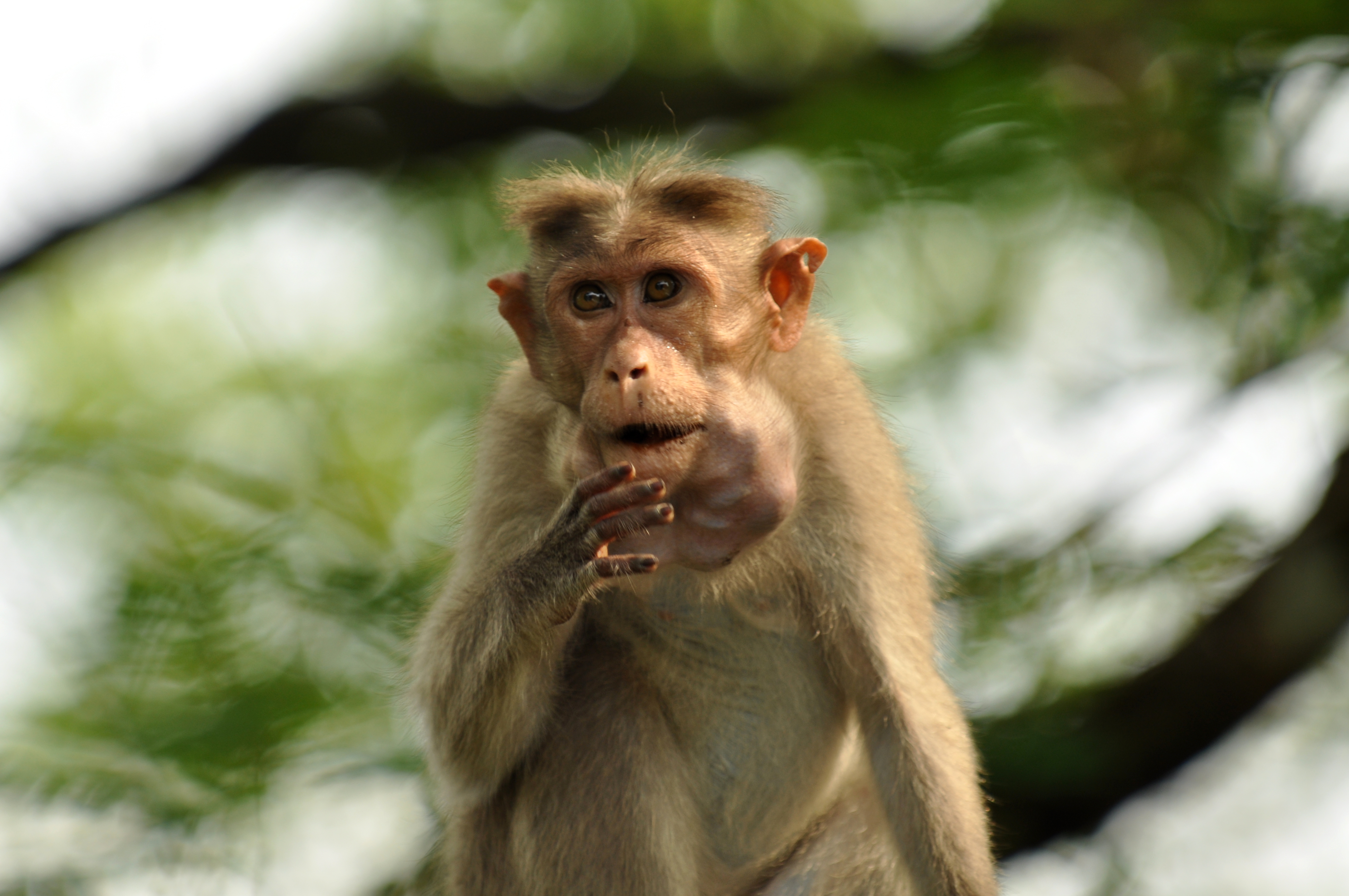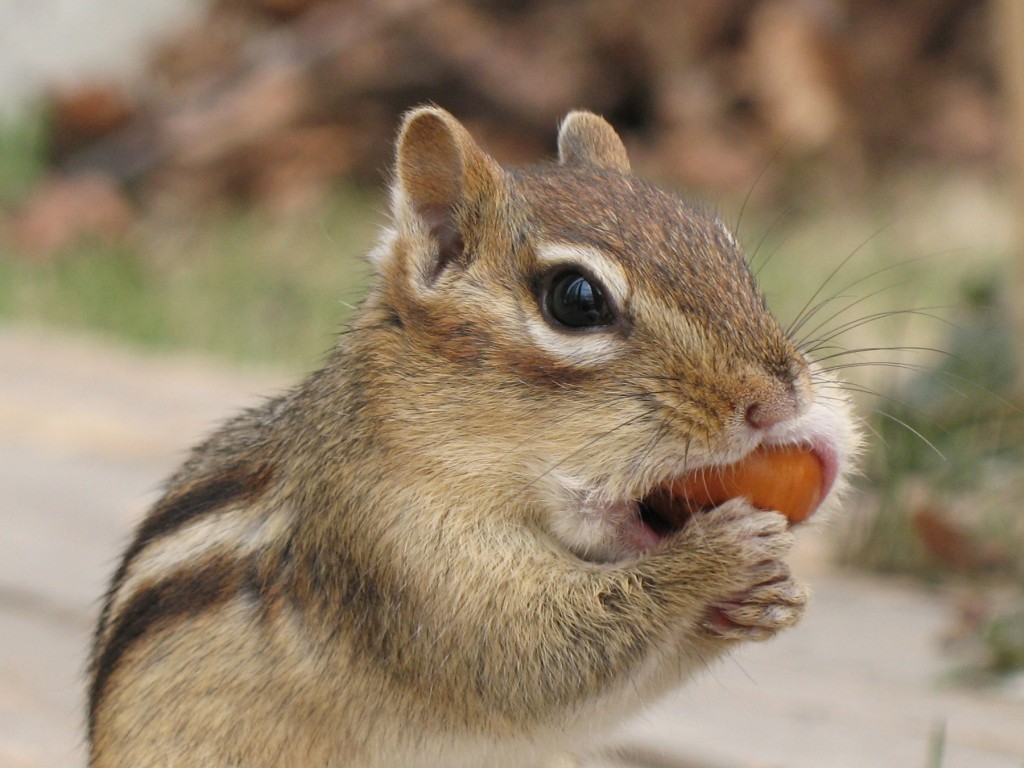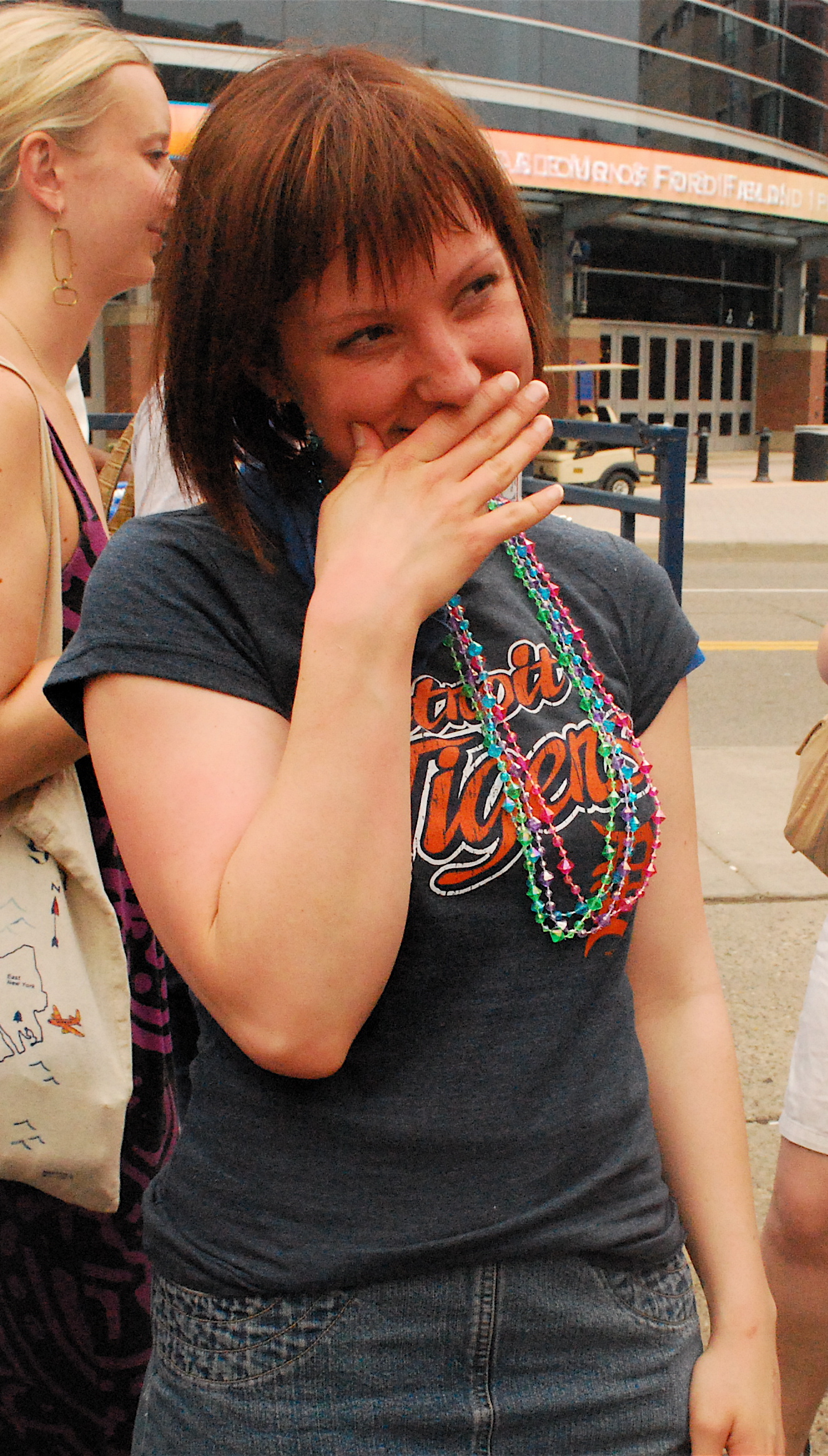|
Cheek
The cheeks ( la, buccae) constitute the area of the face below the eyes and between the nose and the left or right ear. "Buccal" means relating to the cheek. In humans, the region is innervated by the buccal nerve. The area between the inside of the cheek and the teeth and gums is called the vestibule or buccal pouch or buccal cavity and forms part of the mouth. In other animals the cheeks may also be referred to as jowls. Structure Humans Cheeks are fleshy in humans, the skin being suspended by the chin and the jaws, and forming the lateral wall of the human mouth, visibly touching the cheekbone below the eye. The inside of the cheek is lined with a mucous membrane (buccal mucosa, part of the oral mucosa). During mastication (chewing), the cheeks and tongue between them serve to keep the food between the teeth. Other animals The cheeks are covered externally by hairy skin, and internally by stratified squamous epithelium. This is mostly smooth, but may have caudally di ... [...More Info...] [...Related Items...] OR: [Wikipedia] [Google] [Baidu] |
Buccal Pouch
Cheek pouches are pockets on both sides of the head of some mammals between the jaw and the cheek. They can be found on mammals including the platypus, some rodents, and most monkeys, as well as the marsupial koala. The cheek pouches of chipmunks can reach the size of their body when full. Description and function Cheek pouches are located in the thickness of the flange on both sides of the head of some mammals. Monkeys have open cheek pouches within the oral cavity, but they open out in some rodents of America. Hence the name "diplostomes" is associated with them, which means "two mouths." In some rodents, such as hamsters, the cheek pouches are remarkably developed; they form two bags ranging from the mouth to the front of the shoulders. Étienne Geoffroy Saint-Hilaire described that some bats of the genus ''Nycteris'' have an amazing form of cheek pouches, as they have a narrow opening, through which the bat can introduce air, closing the nasal canal through a special mechan ... [...More Info...] [...Related Items...] OR: [Wikipedia] [Google] [Baidu] |
Jowl
The cheeks ( la, buccae) constitute the area of the face below the eyes and between the nose and the left or right ear. "Buccal" means relating to the cheek. In humans, the region is innervated by the buccal nerve. The area between the inside of the cheek and the teeth and gums is called the vestibule or buccal pouch or buccal cavity and forms part of the mouth. In other animals the cheeks may also be referred to as jowls. Structure Humans Cheeks are fleshy in humans, the skin being suspended by the chin and the jaws, and forming the lateral wall of the human mouth, visibly touching the cheekbone below the eye. The inside of the cheek is lined with a mucous membrane (buccal mucosa, part of the oral mucosa). During mastication (chewing), the cheeks and tongue between them serve to keep the food between the teeth. Other animals The cheeks are covered externally by hairy skin, and internally by stratified squamous epithelium. This is mostly smooth, but may have caudally direct ... [...More Info...] [...Related Items...] OR: [Wikipedia] [Google] [Baidu] |
Cheek Augmentation
Cheek augmentation is a cosmetic surgical procedure that is intended to emphasize the cheeks on a person's face. To augment the cheeks, a plastic surgeon may place a solid implant over the cheekbone. Injections with the patients' own fat or a soft tissue filler, like Restylane, are also popular. Rarely, various cuts to the zygomatic bone (cheekbone) may be performed. Cheek augmentation is commonly combined with other procedures, such as a face lift or chin augmentation. Implants Materials Cheek implants can be made of a variety of materials. The most common material is solid silicone. In addition, two popular options are high-density porous polyethylene, marketed as '' Medpor'', and ePTFE (expanded polytetrafluoroethylene), better known as ''Gore-Tex''. Both Medpor and ePTFE are inert substances, providing better integration with the underlying tissue and bone than solid silicone. However, in the case of Medpor, the implants' integration and ingrowth with the underlying tissue c ... [...More Info...] [...Related Items...] OR: [Wikipedia] [Google] [Baidu] |
Buccal Artery
The buccal artery (buccinator artery) is a small artery in the head. It branches off the second part of the maxillary artery and supplies the cheek and buccinator muscle. Course It runs obliquely forward, between the pterygoideus internus and the insertion of the temporalis, to the outer surface of the buccinator, to which it is distributed, anastomosing with branches of the facial artery and with the infraorbital. From the infraorbital area, it descends bilaterally in the superficial face along the lateral margin of the nose, then running anti-parallel to the facial artery The facial artery (external maxillary artery in older texts) is a branch of the external carotid artery that supplies structures of the superficial face. Structure The facial artery arises in the carotid triangle from the external carotid arte ... across the lateral oral region. Additional images file:Gray508.png, The arteries of the face and scalp. References External links * () {{Authority ... [...More Info...] [...Related Items...] OR: [Wikipedia] [Google] [Baidu] |
Chipmunk With Full Cheeks
Chipmunks are small, striped rodents of the family Sciuridae. Chipmunks are found in North America, with the exception of the Siberian chipmunk which is found primarily in Asia. Taxonomy and systematics Chipmunks may be classified either as a single genus, ''Tamias'', or as three genera: ''Tamias'', of which the eastern chipmunk (''T. striatus'') is the only living member; ''Eutamias'', of which the Siberian chipmunk (''E. sibiricus'') is the only living member; and ''Neotamias'', which includes the 23 remaining, mostly western North American, species. These classifications were treated as subgenera due to the chipmunks' morphological similarities. As a result, most taxonomies over the twentieth century have placed the chipmunks into a single genus. However, studies of mitochondrial DNA show that the divergence between each of the three chipmunk groups is comparable to the genetic differences between ''Marmota'' and ''Spermophilus'', so the three genera classifications have been ... [...More Info...] [...Related Items...] OR: [Wikipedia] [Google] [Baidu] |
Zygomaticus Major
The zygomaticus major muscle is a muscle of the human body. It extends from each zygomatic arch (cheekbone) to the corners of the mouth. It is a muscle of facial expression which draws the angle of the mouth superiorly and posteriorly to allow one to smile. Bifid zygomaticus major muscle is a notable variant, and may cause cheek dimples. Structure The zygomaticus major muscle originates from the upper margin of the temporal process, part of the lateral surface of the zygomatic bone. It inserts into tissue at the corner of the mouth. Nerve supply The zygomaticus major muscle is supplied by a buccal branch and a zygomatic branch of the facial nerve (VII). Variation The zygomaticus major muscle may occur in a bifid form, with two fascicles that are partially or completely separate from each other but adjacent. Usually a single unit, dimples are caused by variations in form. It is thought that cheek dimples are caused by bifid zygomaticus major muscle. Function The zygomat ... [...More Info...] [...Related Items...] OR: [Wikipedia] [Google] [Baidu] |
Erythema Infectiosum
Erythema infectiosum, fifth disease, or slapped cheek syndrome is one of several possible manifestations of infection by parvovirus B19. Fifth disease typically presents as a rash and is more common in children. While parvovirus B19 can affect humans of all ages, only two out of ten individuals will present with physical symptoms. The name "fifth disease" comes from its place on the standard list of rash-causing childhood diseases, which also includes measles (first), scarlet fever (second), rubella (third), Dukes' disease (fourth, but is no longer widely accepted as distinct from scarlet fever), and roseola (sixth). Treatment is mostly supportive. Signs and symptoms Fifth disease starts with a low-grade fever, headache, rash, and cold-like symptoms, such as a runny or stuffy nose. These symptoms pass, then a few days later, the rash appears. The bright red rash most commonly appears in the face, particularly the cheeks. This is a defining symptom of the infection in children ... [...More Info...] [...Related Items...] OR: [Wikipedia] [Google] [Baidu] |
Blushing
Blushing is the reddening of a person's face due to psychological reasons. It is normally involuntary and triggered by emotional stress associated with passion, embarrassment, shyness, fear, anger, or romantic stimulation. Severe blushing is common in people who have social anxiety in which the person experiences extreme and persistent anxiety in social and performance situations. Summary Blushing is generally distinguished, despite a close physiological relation, from flushing, which is more intensive and extends over more of the body, and seldom has a mental source. If redness persists for abnormal amounts of time after blushing, then it may be considered an early sign of rosacea. Idiopathic craniofacial erythema is a medical condition where a person blushes strongly with little or no provocation. Just about any situation can bring on intense blushing and it may take one or two minutes for the blush to disappear. Severe blushing can make it difficult for the person to feel ... [...More Info...] [...Related Items...] OR: [Wikipedia] [Google] [Baidu] |
High Cheekbones
In the human skull, the zygomatic bone (from grc, ζῠγόν, zugón, yoke), also called cheekbone or malar bone, is a paired irregular bone which articulates with the maxilla, the temporal bone, the sphenoid bone and the frontal bone. It is situated at the upper and lateral part of the face and forms the prominence of the cheek, part of the lateral wall and floor of the orbit, and parts of the temporal fossa and the infratemporal fossa. It presents a malar and a temporal surface; four processes (the frontosphenoidal, orbital, maxillary, and temporal), and four borders. Etymology The term ''zygomatic'' derives from the Ancient Greek , ''zygoma'', meaning "yoke". The zygomatic bone is occasionally referred to as the zygoma, but this term may also refer to the zygomatic arch. Structure Surfaces The ''malar surface'' is convex and perforated near its center by a small aperture, the zygomaticofacial foramen, for the passage of the zygomaticofacial nerve and vessels; below ... [...More Info...] [...Related Items...] OR: [Wikipedia] [Google] [Baidu] |
Cotton Swab
Cotton is a soft, fluffy Staple (textiles), staple fiber that grows in a wikt:boll, boll, or protective case, around the seeds of the cotton plants of the genus ''Gossypium'' in the mallow family Malvaceae. The fiber is almost pure cellulose, and can contain minor percentages of waxes, fats, pectins, and water. Under natural conditions, the cotton bolls will increase the dispersal of the seeds. The plant is a shrub native to tropical and subtropical regions around the world, including the Americas, Africa, Egypt and India. The greatest diversity of wild cotton species is found in Mexico, followed by Australia and Africa. Cotton was independently domesticated in the Old and New Worlds. The fiber is most often Spinning (textiles), spun into yarn or thread and used to make a soft, breathable, and durable textile. The use of cotton for fabric is known to date to prehistoric times; fragments of cotton fabric dated to the fifth millennium BC have been found in the Indus Valley civ ... [...More Info...] [...Related Items...] OR: [Wikipedia] [Google] [Baidu] |
Individual
An individual is that which exists as a distinct entity. Individuality (or self-hood) is the state or quality of being an individual; particularly (in the case of humans) of being a person unique from other people and possessing one's own Maslow's hierarchy of needs, needs or goals, rights and moral responsibility, responsibilities. The concept of an individual features in diverse fields, including biology, law, and philosophy. Etymology From the 15th century and earlier (and also today within the fields of statistics and metaphysics) ''individual'' meant "divisible, indivisible", typically describing any numerically singular thing, but sometimes meaning "a person". From the 17th century on, ''individual'' has indicated separateness, as in individualism. Law Although individuality and individualism are commonly considered to mature with age/time and experience/wealth, a sanity, sane adult human, human being is usually considered by the State (polity), state as an "individu ... [...More Info...] [...Related Items...] OR: [Wikipedia] [Google] [Baidu] |







